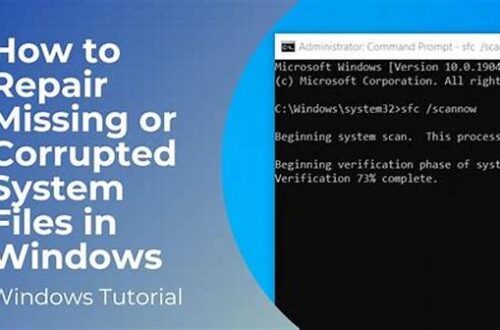The modern computer user often grapples with the intricacies of managing their system to ensure optimal performance. One of the critical areas to address is managing the programs that automatically start when you power on your computer. This is commonly referred to as managing startup programs. The need to reduce Windows startup programs has become increasingly pertinent, as an excess of these applications launching at startup can drastically slow down the boot time and overall efficiency of the system.
Read Now : Essential Cybersecurity Tools For Windows
Why Reduce Windows Startup Programs?
Reducing Windows startup programs can lead to significant improvements in your computer’s performance. When you allow too many programs to start up simultaneously, it consumes a large chunk of your system’s resources. This not only affects boot time but may also slow down overall performance as these applications run in the background. Moreover, some startup programs may not be necessary for immediate usage and could be manually launched when needed. By taking control over which applications launch at startup, you can ensure that your machine runs smoothly, which is especially beneficial for older computers where resources are limited. In essence, opting to reduce Windows startup programs is a vital step in maintaining a fast and responsive system.
With the multitude of applications that we tend to install on our computers, it is common to inadvertently allow many of them to launch at startup. This happens because the installation process for many programs defaults to starting them automatically with Windows. Therefore, users who want to maintain optimal performance must take proactive steps to assess and reduce Windows startup programs. Not only does this approach improve performance, but it also enhances security. Malware often disguises itself as startup programs, and by managing these, you can mitigate potential security risks. In conclusion, taking the time to reduce Windows startup programs is an essential practice for anyone looking to optimize their Windows experience.
Steps to Reduce Windows Startup Programs
1. Open the Task Manager by pressing `Ctrl + Shift + Esc`, or by right-clicking on the taskbar and selecting Task Manager.
2. Navigate to the ‘Startup’ tab to see the list of programs set to run at startup.
3. Identify unnecessary programs that could slow down your startup time.
4. Right-click on the program you wish to disable and select ‘Disable’.
5. Restart your computer to see the changes in effect.
Understanding the Importance to Reduce Windows Startup Programs
To reduce Windows startup programs not only makes your computer boot faster but also extends the overall lifespan of your hardware by ensuring it doesn’t overwork during startup. A computer that struggles to handle the demands of numerous startup programs may experience frequent crashes or even hardware damage over time.
Reducing unnecessary startup programs is a proactive way to keep your system running efficiently. By regularly checking and adjusting which programs are allowed to launch at startup, you anticipate future performance issues. This practice also sets a foundation for better system maintenance and assists in preserving the life of your computer. Additionally, reducing startup programs helps in diagnosing other potential system issues by isolating non-essential applications that might be causing conflicts.
Techniques to Effectively Reduce Windows Startup Programs
1. Use System Configuration: Access System Configuration via `msconfig` and navigate to the ‘Startup’ tab to manage programs.
2. Utilizing Built-in Windows Tools: Windows provides built-in features like Task Manager to easily disable unnecessary startup items.
3. Third-Party Applications: Consider third-party tools designed to manage startup programs for a more user-friendly interface.
4. Regular Maintenance: Periodically review your startup list and adjust as new software is installed.
5. Safe Mode Troubleshooting: Boot into safe mode to identify problematic programs without other startup programs interfering.
Read Now : Detecting Malware On Windows Systems
6. Remove Unnecessary Software: Uninstall unwanted or unused applications altogether to prevent them from appearing in the startup list.
7. Check for Malware: Regular scans can prevent malicious software disguised as startup programs.
8. Review System Impact: Use tools that provide insight into how each startup item affects boot time and system resources.
9. Backup Settings: Before making changes, consider backing up current system settings to restore if needed.
10. Stay Informed: Keep abreast of Windows updates and adjust setting options as they develop new utilities or features.
Ensuring Smooth Operation Post-Reduction
After you take steps to reduce Windows startup programs, it is crucial to monitor the performance of your system to ensure everything runs smoothly. Assess the effectiveness of your adjustments by observing boot times and overall system responsiveness. This process should be methodical, involving a detailed inspection of which programs you choose to disable and confirming that essential functions remain operational.
However, be cautious about indiscriminately disabling certain applications, as some programs perform critical functions, such as antivirus software or system updates. These are designed to run at startup for a reason. Therefore, when you reduce Windows startup programs, ensure that vital applications remain active to avoid compromising your system’s security and functionality.
Moreover, the benefits of reducing startup programs are not limited to improvements in startup speed and performance. Reducing startup programs also contributes to more streamlined management of system resources, freeing up valuable CPU and memory resources for other tasks. Over time, as you adopt the practice of managing startup programs, it will become easier to maintain an efficient, secure, and performance-oriented computer environment.
Benefits of Regularly Reducing Windows Startup Programs
Regularly engaging in activities to reduce Windows startup programs can be incredibly beneficial for maintaining optimal system performance. It promotes faster boot times, efficiencies in program execution, and the better allocation of system resources. Importantly, regularly reviewing startup programs can avert unexpected slowdowns caused by unauthorized or unnecessary applications running in the background.
Additionally, reducing startup programs plays a crucial role in enhancing system security. Many pieces of malicious software operate under the guise of legitimate startup programs. Often, a basic review of your startup settings can reveal such threats, allowing prompt action to be taken. Thus, actively managing these settings helps mitigate the risk of potential security exposures.
Conclusively, by adopting a practice of reducing Windows startup programs, users can significantly improve both the performance and longevity of their computer systems. It is an essential maintenance task that, while often overlooked, yields considerable improvements over time and is a fundamental step in optimizing the Windows computing experience.





